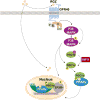PPARγ signaling and emerging opportunities for improved therapeutics
- PMID: 27268145
- PMCID: PMC5026568
- DOI: 10.1016/j.phrs.2016.02.028
PPARγ signaling and emerging opportunities for improved therapeutics
Abstract
Peroxisome proliferator-activated receptor gamma (PPARγ) is a ligand-activated nuclear receptor that regulates glucose and lipid metabolism, endothelial function and inflammation. Rosiglitazone (RGZ) and other thiazolidinedione (TZD) synthetic ligands of PPARγ are insulin sensitizers that have been used for the treatment of type 2 diabetes. However, undesirable side effects including weight gain, fluid retention, bone loss, congestive heart failure, and a possible increased risk of myocardial infarction and bladder cancer, have limited the use of TZDs. Therefore, there is a need to better understand PPARγ signaling and to develop safer and more effective PPARγ-directed therapeutics. In addition to PPARγ itself, many PPARγ ligands including TZDs bind to and activate G protein-coupled receptor 40 (GPR40), also known as free fatty acid receptor 1. GPR40 signaling activates stress kinase pathways that ultimately regulate downstream PPARγ responses. Recent studies in human endothelial cells have demonstrated that RGZ activation of GPR40 is essential to the optimal propagation of PPARγ genomic signaling. RGZ/GPR40/p38 MAPK signaling induces and activates PPARγ co-activator-1α, and recruits E1A binding protein p300 to the promoters of target genes, markedly enhancing PPARγ-dependent transcription. Therefore in endothelium, GPR40 and PPARγ function as an integrated signaling pathway. However, GPR40 can also activate ERK1/2, a proinflammatory kinase that directly phosphorylates and inactivates PPARγ. Thus the role of GPR40 in PPARγ signaling may have important implications for drug development. Ligands that strongly activate PPARγ, but do not bind to or activate GPR40 may be safer than currently approved PPARγ agonists. Alternatively, biased GPR40 agonists might be sought that activate both p38 MAPK and PPARγ, but not ERK1/2, avoiding its harmful effects on PPARγ signaling, insulin resistance and inflammation. Such next generation drugs might be useful in treating not only type 2 diabetes, but also diverse chronic and acute forms of vascular inflammation such as atherosclerosis and septic shock.
Keywords: E1A binding protein p300 (EP300); G protein-coupled receptor 40 (GPR40); P38 mitogen-activated protein kinase (p38 MAPK); PPARγ co-activator-1alpha (PGC-1α); Peroxisome proliferator-activated receptor gamma (PPARγ); Thiazolidinediones (TZDs).
Published by Elsevier Ltd.
Conflict of interest statement
The authors declare that they have no conflicts of interest with the contents of this article.
Figures
Similar articles
-
G Protein-coupled Receptor 40 (GPR40) and Peroxisome Proliferator-activated Receptor γ (PPARγ): AN INTEGRATED TWO-RECEPTOR SIGNALING PATHWAY.J Biol Chem. 2015 Aug 7;290(32):19544-57. doi: 10.1074/jbc.M115.638924. Epub 2015 Jun 23. J Biol Chem. 2015. PMID: 26105050 Free PMC article.
-
PPAR-γ activation increases insulin secretion through the up-regulation of the free fatty acid receptor GPR40 in pancreatic β-cells.PLoS One. 2013;8(1):e50128. doi: 10.1371/journal.pone.0050128. Epub 2013 Jan 23. PLoS One. 2013. PMID: 23372643 Free PMC article.
-
Peroxisome proliferator-activated receptor gamma-independent activation of p38 MAPK by thiazolidinediones involves calcium/calmodulin-dependent protein kinase II and protein kinase R: correlation with endoplasmic reticulum stress.J Biol Chem. 2005 Mar 18;280(11):10109-18. doi: 10.1074/jbc.M410445200. Epub 2005 Jan 13. J Biol Chem. 2005. PMID: 15649892
-
PPARγ signaling and metabolism: the good, the bad and the future.Nat Med. 2013 May;19(5):557-66. doi: 10.1038/nm.3159. Epub 2013 May 7. Nat Med. 2013. PMID: 23652116 Free PMC article. Review.
-
Peroxisome proliferator-activated receptor gamma agonists as insulin sensitizers: from the discovery to recent progress.Curr Top Med Chem. 2008;8(17):1483-507. doi: 10.2174/156802608786413474. Curr Top Med Chem. 2008. PMID: 19075761 Review.
Cited by
-
H3K9me3 demethylation by JMJD2B is regulated by pirfenidone resulting in improved NASH.Sci Rep. 2024 Oct 21;14(1):24714. doi: 10.1038/s41598-024-75458-2. Sci Rep. 2024. PMID: 39433954 Free PMC article.
-
Research progress on the molecular mechanism of coronary microvascular endothelial cell dysfunction.Int J Cardiol Heart Vasc. 2021 Apr 10;34:100777. doi: 10.1016/j.ijcha.2021.100777. eCollection 2021 Jun. Int J Cardiol Heart Vasc. 2021. PMID: 33912653 Free PMC article. Review.
-
Trans-repression of NFκB pathway mediated by PPARγ improves vascular endothelium insulin resistance.J Cell Mol Med. 2019 Jan;23(1):216-226. doi: 10.1111/jcmm.13913. Epub 2018 Nov 5. J Cell Mol Med. 2019. PMID: 30398029 Free PMC article.
-
Metabolic Syndrome Is Reduced in C57BL/6J Mice Fed High-Fat Diets Supplemented with Oak Tannins.Curr Dev Nutr. 2020 Mar 13;4(4):nzaa033. doi: 10.1093/cdn/nzaa033. eCollection 2020 Apr. Curr Dev Nutr. 2020. PMID: 32258991 Free PMC article.
-
Indomethacin promotes browning and brown adipogenesis in both murine and human fat cells.Pharmacol Res Perspect. 2020 Jun;8(3):e00592. doi: 10.1002/prp2.592. Pharmacol Res Perspect. 2020. PMID: 32430973 Free PMC article.
References
-
- Chen L, Magliano DJ, Zimmet PZ. The worldwide epidemiology of type 2 diabetes mellitus–present and future perspectives. Nat Rev Endocrinol. 2012;8(4):228–236. - PubMed
-
- Yki-Jarvinen H. Thiazolidinediones. N Engl J Med. 2004;351(11):1106–1118. - PubMed
-
- Sohda T, Mizuno K, Imamiya E, Sugiyama Y, Fujita T, Kawamatsu Y. Studies on antidiabetic agents. II. Synthesis of 5-[4-(1-methylcyclohexylmethoxy)-benzyl]thiazolidine-2,4-dione (ADD-3878) and its derivatives. Chem Pharm Bull (Tokyo) 1982;30(10):3580–3600. - PubMed
-
- Fujita T, Sugiyama Y, Taketomi S, Sohda T, Kawamatsu Y, Iwatsuka H, Suzuoki Z. Reduction of insulin resistance in obese and/or diabetic animals by 5-[4-(1-methylcyclohexylmethoxy)benzyl]-thiazolidine-2,4-dione (ADD-3878, U-63,287, ciglitazone), a new antidiabetic agent. Diabetes. 1983;32(9):804–810. - PubMed
-
- Fujiwara T, Yoshioka S, Yoshioka T, Ushiyama I, Horikoshi H. Characterization of new oral antidiabetic agent CS-045. Studies in KK and ob/ob mice and Zucker fatty rats. Diabetes. 1988;37(11):1549–1558. - PubMed
Publication types
MeSH terms
Substances
Grants and funding
LinkOut - more resources
Full Text Sources
Other Literature Sources
Medical
Molecular Biology Databases
Miscellaneous


